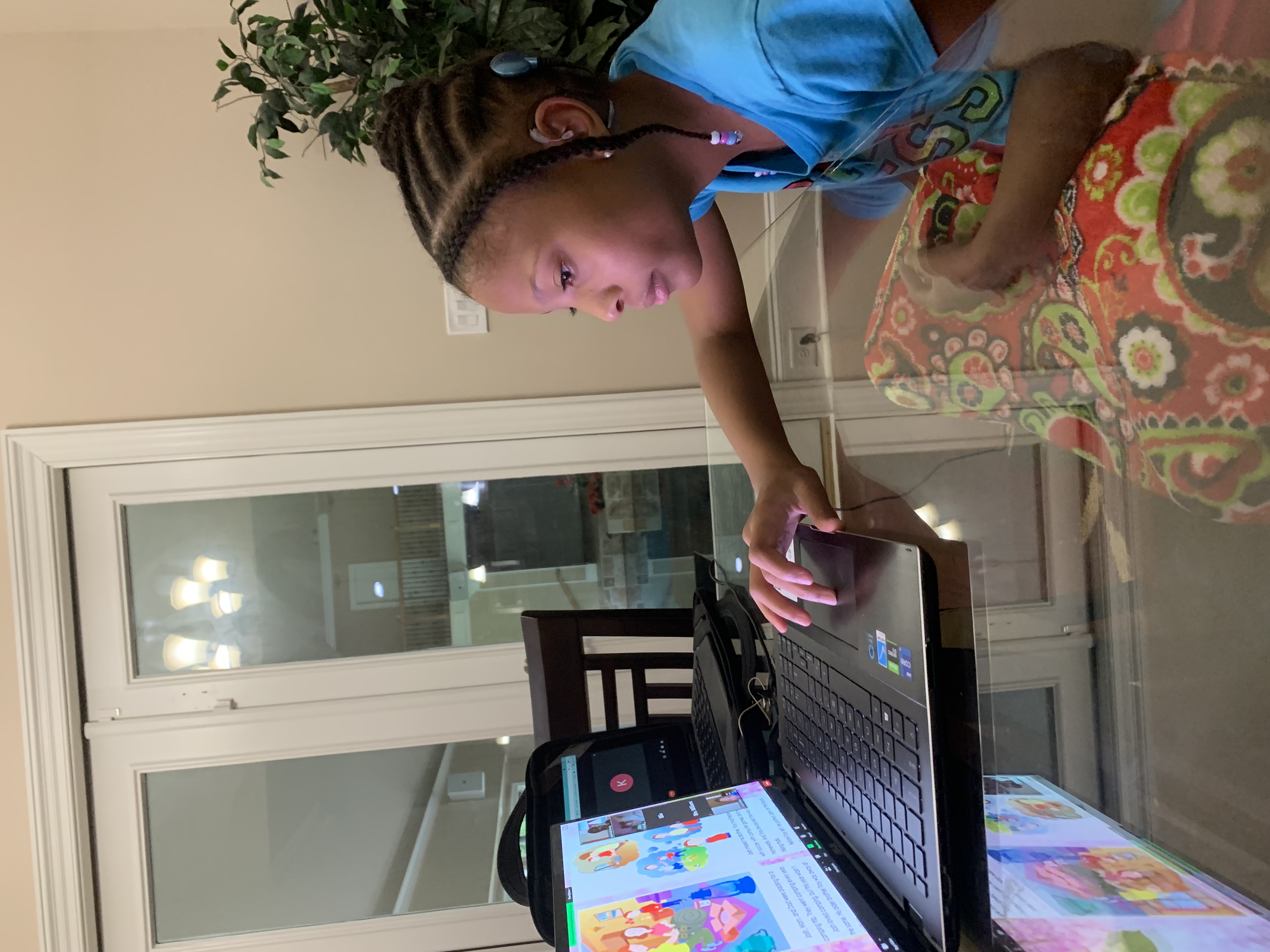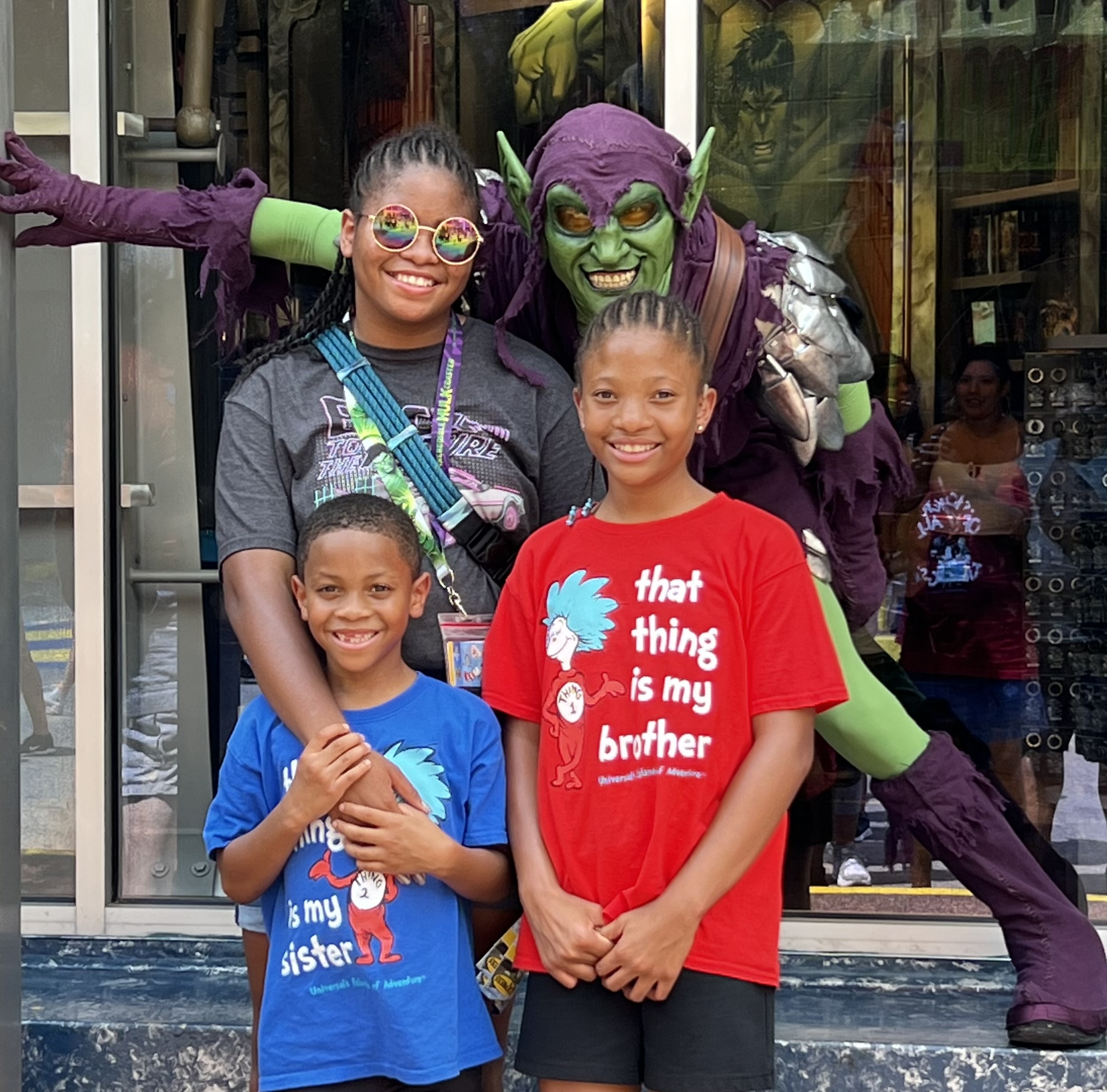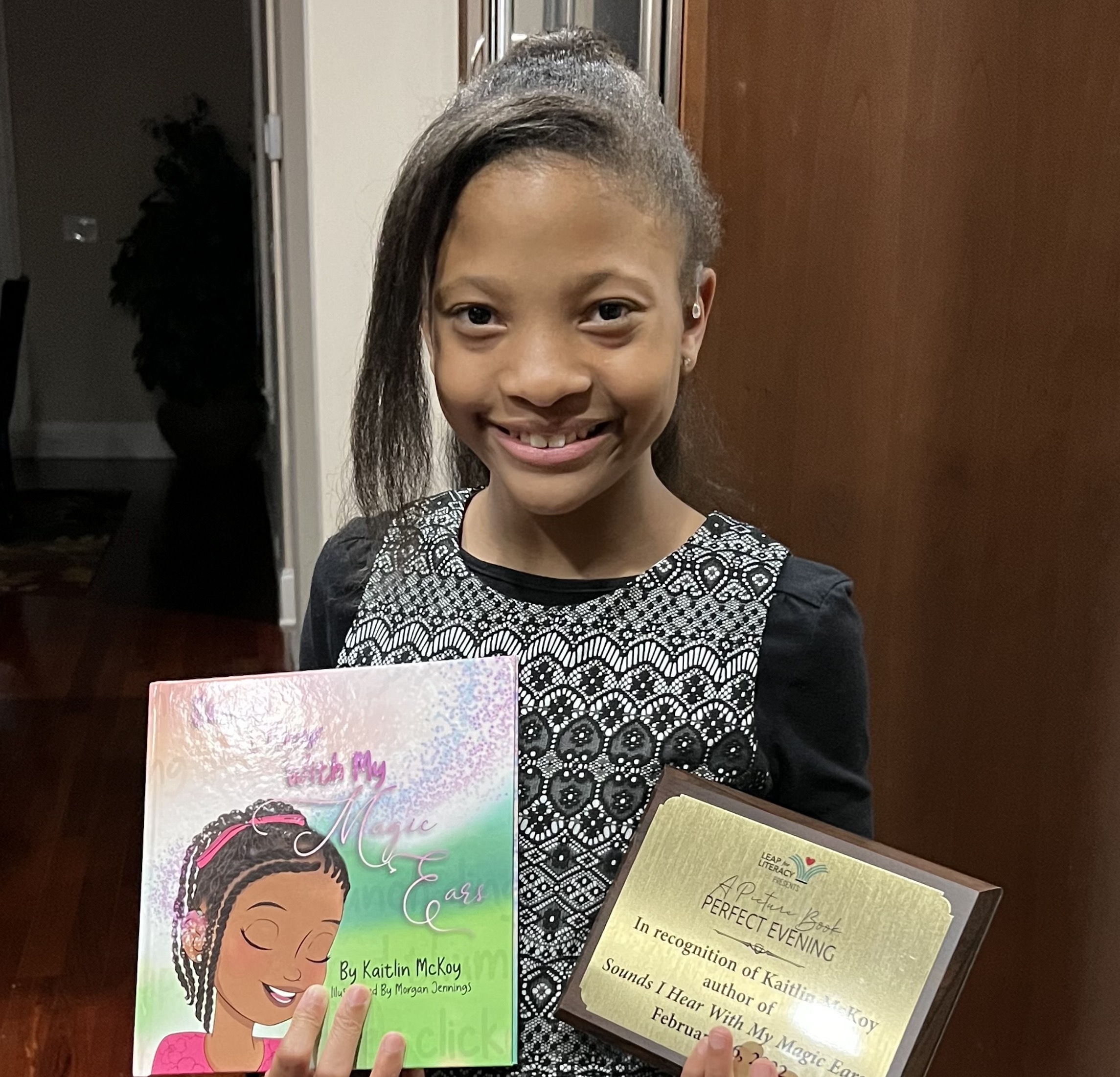For a third grade school assignment, Kaitlin McKoy decided to write about her ears.
by Kirsten Ballard
Kaitlin McKoy has magic ears that help her hear her favorite sounds. Every day, she puts them on. Often, her friends at school ask about them—what are those things? What can you hear?
 For a third grade school assignment, she decided to write about her ears.
For a third grade school assignment, she decided to write about her ears.
Now, Kaitlin, 11, is a published author. Her book, “Sounds I Hear with My Magic Ears,” was published in February 2022 and is now sold on Amazon.
She was born profoundly deaf. Her mother, Saundra, says when Kaitlin was born, she was given only a 40% chance of survival.
“She was actually born at 26 weeks. She was one pound, 14 ounces,” Saundra says. “She was a micro preemie. She was so small. Doctors said if she did survive, she would have all of these issues. I was determined that’s not what we were going to do. We worked very, very hard and joined a lot of different advocacy programs.”
Due to her size, Kaitlin had to wait until she was two to get her cochlear implants. She said her first words at 4 years old.
“I had to realize, as a parent, that the implant did not immediately solve the problem,” Saundra says. The audiologist warned Saundra moving forward would be a long journey.
“The doctor said, ‘Don’t give up,’” she says. “We did everything she advised us to do. And now Kaitlin is talking and, while we do have a few other cognitive issues, we are still moving forward.”
Getting her to wear her processors was a struggle, Saundra says. “So to help her want to wear them, we started calling them her ears. ‘Kaitlin, put your ears on. You gotta get your ears. Remember they’re magic ears, they’re going to help you hear.’ We tried to let her know these are special, they’re unique. They’re magic.”
Kaitlin goes to a mainstream school near her home in Tyrone, Georgia. Almost 900 students attend Peeples Elementary, but the program for students who are deaf and hard of hearing is quite small. Saundra says her daughter is one of only two students who wear CIs.
At school, Kaitlin has a full team dedicated to helping her learn. She attends mainstream math and science and works with her teacher of the deaf and hard of hearing during language arts and reading. She has a full-time interpreter to make sure she’s able to understand everything. She works with a speech teacher as well.
She was in third grade during the pandemic and attending virtual learning—at one point she had three screens open to be able to participate in class. Her school teacher wanted her to participate in a language arts assignment on narrative writing.
“[Her teacher] said I think Kaitlin can participate in this writing project, we’ll just let her write it on her level,” Saundra says.
Kaitlin decided to write about her ears. The project took three months, from brainstorming to drafting to proofreading. Kaitlin drew on the frequent questions she’s asked about her CIs to write the book.
“People ask me, ‘What’s that on your ear?’ and I tell them, ‘These are my ears to help me hear,’” she says.
She also wrote about her favorite (and least favorite) sounds.
“I like to hear music and I like to hear when my dog barks. I like to hear my family say ‘I love you’ at night,” she says. In the least favorite category? Thunderstorms and bees.
“She typed it. She drew pictures for it. She really put a lot of time and effort into it,” Saundra says. The school was competing in the Leap for Literacy program, where two stories would be chosen as winners. “Her teacher saw [her effort] and she entered it into the contest and the Director of Leap for Literacy read her story and said ‘I have to meet this little girl.’ Even though she didn’t win for the school, she won for him and he published her book. That’s how it got published. We didn’t start out writing a book, we started out writing a story.”
Through Leap for Literacy, “Sounds I Hear With My Magic Ears” was turned into a full book with a professional illustrator.
Kaitlin went on the YouTube show, “The Very Airy Library with Stan Tucker,” to see the published book for the first time. She gasped when she saw her finished book. The illustrations look exactly like her.
Her friends at school are in awe of the young author.
“They say that I did really good job and they say they’re very, very proud of me and they say, “How did you write that book?’” she says.
Kaitlin wants to write another book, this time about her life and family.
 “I was just excited that she had the opportunity to do this,” her mom says.
“I was just excited that she had the opportunity to do this,” her mom says.
Las orejas mágicas de Kaitlin
Kaitlin McKoy tiene unos oídos mágicos que le ayudan a oír sus sonidos preferidos. Se los pone todos los días. En la escuela, a menudo sus amigos se interesan por ellos: ¿qué son esos aparatos?, ¿qué puedes oír?
Para una tarea escolar de tercer curso, decidió escribir sobre ellos.
En la actualidad, Kaitlin, que tiene 11 años, es una autora publicada. Su libro «Sounds I Hear with My Magic Ears» (Sonidos que oigo con mis oídos mágicos) se publicó en febrero de 2022 y se vende en Amazon.
Kaitlin nació con una sordera profunda. Saundra, su madre, cuenta que cuando nació solo se estimaba que tendría un 40 % de posibilidades de sobrevivir.
«Nació a las 26 semanas de gestación. Pesaba una libra y 14 onzas», explica. «Era un bebé microprematuro. Era muy pequeña. Los médicos decían que, en el caso de que sobreviviese, tendría todos estos problemas, pero yo estaba decidida a hacer lo que fuese necesario. Trabajamos con afán y nos incorporamos a diferentes programas de defensa y promoción».
Debido a su tamaño, hubo que esperar a que Kaitlin tuviese dos años para que recibiese implantes cocleares. Dijo sus primeras palabras a los 4 años.
«Como madre, tuve que asimilar que los implantes no resolvían de inmediato el problema», dice Saundra. La audióloga le advirtió que tendrían por delante un largo camino.
«La doctora me decía: “no hay que rendirse”». «Hicimos todo lo que nos aconsejó que hiciéramos y actualmente Kaitlin habla y, si bien existen otros problemas cognitivos, seguimos hacia delante».
Conseguir que llevase los procesadores era una lucha diaria, dice Saundra. «Para incentivarle, empezamos a llamarles sus oídos. “Kaitlin, ponte los oídos. Tienes que ponértelos. Recuerda que son oídos mágicos y que te ayudarán a oír”. Tratamos de que entendiera que eran especiales, únicos. Eran mágicos».
Kaitlin asiste a una escuela del sistema educativo ordinario cerca de su casa en Tyrone, Georgia. Casi 900 alumnos estudian en Peeples Elementary, pero el programa para alumnos con sordera e hipoacusia es bastante reducido. Saundra dice que su hija es uno de los dos únicos alumnos que utilizan implantes cocleares.
En la escuela, Kaitlin dispone de un equipo completo dedicado a ayudarle en el aprendizaje. Acude a las clases ordinarias de matemáticas y ciencias, y trabaja con su profesor de sordos durante las clases de «artes del lenguaje» (escucha, lectura, habla y escritura). Dispone de un intérprete de tiempo completo con el fin de que sea capaz de entender todo. También trabaja con un logopeda.
Durante la pandemia, se encontraba en tercer curso y asistía al aprendizaje virtual; en un momento dado, tenía tres pantallas abiertas para poder participar en clase. La maestra de la clase deseaba que participase en una tarea de «artes del lenguaje», concretamente en escritura narrativa.
«[La maestra] dijo que pensaba que Kaitlin podía participar en este proyecto de escritura y que debíamos dejar que lo hiciese a su propio nivel», dice Saundra.
Kaitlin decidió escribir sobre sus oídos. En el proyecto se tardaron tres meses, desde la lluvia de ideas hasta la redacción y la revisión. Kaitlin se basó en las preguntas frecuentes que le planteaban sobre sus implantes cocleares para escribir el libro.
«La gente me pregunta “¿qué llevas en los oídos?” y les contesto “son mis oídos que me ayudan a oír”», explica.
También escribió sobre sus sonidos preferidos (y los menos preferidos).
«Me gusta oír música y también cuando mi perro ladra. Me gusta oír a mi familia cuando me dice “te amo” cuando me voy a dormir». ¿Cuál es tu categoría menos preferida? Las tormentas y las abejas.
«Lo mecanografió todo. Lo acompañó de dibujos . La verdad es que le dedicó mucho tiempo y esfuerzo», comenta Saundra. La escuela competía en el programa «Leap for Literacy» (Un salto hacia la lectoescritura), en el que se seleccionarían dos relatos como ganadores. «La maestra apreció su esfuerzo e inscribió el relato en el concurso. El director de «Leap for Literacy» lo leyó y dijo: “tengo que conocer a esta niña”. Si bien el relato no fue ganador en la escuela, lo fue para el director que lo publicó en un libro. Así es como se publicó. No empezamos a escribir un libro, empezamos a escribir un relato».
A través de «Leap for Literacy», «Sounds I Hear With My Magic Ears» se convirtió en un libro completo ilustrado por un profesional.
Kaitlin apareció en el programa de YouTube «The Very Airy Library with Stan Tucker» para ver el libro publicado por primera vez. Se quedó atónita cuando vio el libro terminado. Las ilustraciones la reflejaban exactamente.
Sus amigos de la escuela mostraron su asombro por la joven autora.
«Me dicen que he hecho un gran trabajo, que se sienten muy orgullosos de mí y me preguntan “¿cómo escribiste el libro?”», añade.
Kaitlin quiere escribir otro libro, esta vez sobre su vida y su familia.
«Me emocionó que tuviera la oportunidad de hacer algo así», asegura su madre.

